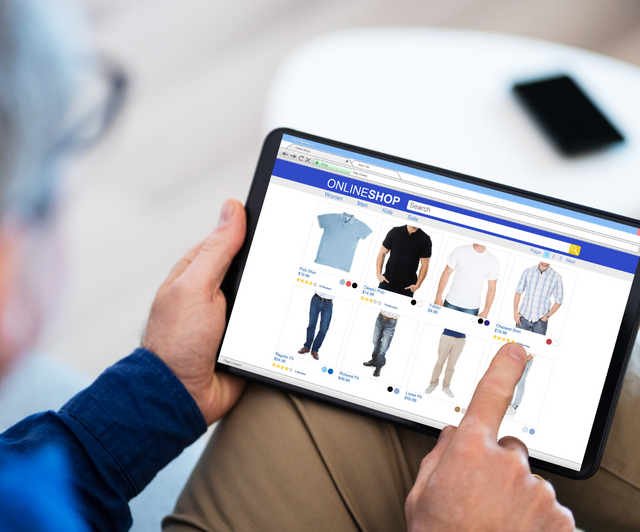Key Content Elements That Drive Engagement in eCommerce
Are you noticing that traffic to your eCommerce website is great but people aren’t sticking around to make a purchase? Are they landing on a page but leaving promptly after without engaging with the site?
When it comes to eCommerce design, it can be difficult to know which content to include in order to drive engagement and encourage potential customers to purchase from you.
In today’s fast-paced world, attention spans are shrinking and first impressions count more than ever. In just 50 milliseconds, a user forms an opinion about your website and that opinion will determine whether they stay or leave. This is particularly crucial for eCommerce websites, where visitors are looking to make purchases. Therefore, it’s essential to create a positive and lasting impression on potential customers.
So, how on earth do I do that?
Which piece of content is the most engaging?
Images are considered to be the most eye-catching element on a webpage for eCommerce customers, with users spending an average of 6 seconds looking at images on a webpage*. High-quality product images are extremely effective at driving engagement and sales on eCommerce websites. 67% of consumers consider clear, detailed images to be “very important” when making a purchasing decision*.
Images not only showcase the product but also convey its unique features, quality and value. The human brain processes images faster than text so it’s crucial to ensure that your images are well-lit and visually appealing. We also recommend displaying multiple angles of the product and include a zoom feature to allow users to inspect its features closely.
Which other types of content receive high engagement?
From fun quizzes and polls to compelling videos and helpful chat bots, a study by Demand Metric found that interactive content generates double the number of conversions than passive content*.
Passive content includes anything from product descriptions and specifications to FAQs. Although essential for providing information to customers, it often fails to engage users enough to make a sale.
Conversely, interactive content like product customisation encourages your target customers to actively engage and participate, creating an exciting and customisable shopping experience. By putting the decision making directly in their hands, you will enhance customer satisfaction and increase loyalty and repeat purchases.
Two of the most engaging and interactive content features you should consider incorporating on your eCommerce store are:
Videos: Videos can showcase your products and provide useful information about them in a captivating way. Product videos allow potential customers to see the product in action, while educational videos are great for sharing handy tips and tricks.
Virtual tours, 360-degree product videos and shoppable videos will drive interest and engagement further. Have you seen those interactive ads which let you decide the storyline? These can be used to tell a story about a product in a fun and creative way (like a game!) that puts customers at the heart of the action and leads to a purchase.
Remember to keep videos relatively short and sweet to maintain the attention of your audience.
Calls to action (CTAs): Clear and prominent CTAs that use imperatives such as “Add to Cart” or “Buy Now” are crucial for driving engagement and conversions on eCommerce websites. Make sure to dot call-to-action buttons and links all over your site as a roadmap for visitors. CTAs are the third most eye-catching element on a webpage for eCommerce customers, with users spending an average of 2.5 seconds looking at calls-to-action on a webpage*.
Other key content elements to include on your eCommerce website are:
Customer reviews: Including customer reviews on your product pages can help to build trust with your audience and provide valuable social proof. According to a study by Reevo, 73% of consumers say that they trust a product more if it has good reviews*.
Product personalisation: Providing personalised and informative product features can help visitors understand how your product solves their problems. Step into the shoes of your ideal customer and, instead of simply describing the features, sell the benefits. How will it make their life easier? To increase the chance of a sale, make sure you use descriptions to answer any questions potential customers may have.
There are plenty more key content elements we could mention that will drive engagement and persuade visitors to your eCommerce store to buy from you but we’d be here a while!
Whichever you choose, make sure to mix it up by using different content types and formats to capture attention and keep your ideal customer coming back for more. Break up the text with images and video and keep it fresh and interesting with blog posts, how-to guides, infographics, podcasts, interviews and more. Include plenty of whitespace and don’t overcrowd pages by uploading everything at once – tease your visitors by saying “Stay tuned, more to come soon …”.
Where should content be placed?
Customers tend to follow a predictable visual hierarchy when scanning a webpage, with the majority of their attention focused on the top left and centre of the page*.
This means that when it comes to eCommerce design, it’s important to place key elements, such as your logo, main navigation and calls-to-action in these areas of the page. Design your navigation bar in a way that makes it easy for customers to find the products and categories that they’re interested in.
How much content can you have on a page?
It might be tempting to throw every interactive content element you can think of onto each page of your eCommerce store but don’t get too carried away!
The amount of content that should be included on each page of an eCommerce website depends on several factors, including the purpose of the page, the target audience and the type of product being sold. In general, it’s best to aim for a balance between providing enough information to help customers make informed purchasing decisions and avoiding overwhelming them with too much information.
For product pages, it’s important to provide enough information to help customers understand the product’s features, benefits and specifications. This may include a product description, high-quality images, customer reviews, pricing information and any relevant product details such as dimensions, materials or care instructions.
For category pages, the amount of content may vary depending on the type of product being sold and the target audience. In general, it’s a good idea to provide a brief overview of the product category, along with images and links to individual product pages. It’s also important to keep category pages well-organised and easy to navigate, so customers can quickly find what they’re looking for.
Which eCommerce platform is best to effectively manage content?
By having your eCommerce store on an agile platform such as BigCommerce, or by using a CMS like Storyblok, you will have the flexibility to organise, move and update various content elements on your store’s pages, making it easier to keep up with changing trends and customer demands.
The key benefits of using an agile eCommerce platform include:
- Make changes quickly in real-time, without waiting for developers or IT support.
- Move content elements around to highlight specific products or promotions in a way that is visually appealing, capturing the attention of your audience.
- Organise content in a way that makes sense for your business. Content can be grouped together based on product categories or promotions, making it easier for customers to find what they’re looking for. This type of organisation is essential for eCommerce stores that offer a wide range of products, as it helps to reduce the time and effort required to find specific items.
What could happen if I don’t add engaging content to my eCommerce website?
- You risk having a dull and unappealing website that lacks information and value. Visitors to your website will be hesitant to make a purchase if they don’t have enough information about the products or services they’re interested in.
- Customers may lose interest and move on to a competitor’s site, resulting in a higher bounce rate, lower conversion rate and ultimately, decreased sales. And you don’t want them to have all the business!
- If you don’t have enough relevant and high-quality content on your eCommerce store, it may not appear in search engine results, leading to a significant loss of traffic and therefore, potential customers.
- People who view your website may not recommend your brand to others, resulting in reduced traffic and lower sales.
- It may be harder to build trust with your audience and establish your brand as an authority in your industry.
So it’s a bit of a no brainer!
If you’re finding this all a little overwhelming and you’re not sure where to start, you’re worried about cost or you simply don’t have the time to produce interactive and engaging content elements for your eCommerce store, get in touch with us and we’ll be happy to assist you.
*https://www.mdgsolutions.com/learn-about-multi-location-marketing/its-all-about-the-images-infographic, https://www.nngroup.com/articles/first-impressions-human-automaticity, https://www.nngroup.com/articles/visual-hierarchy-ux-definition, https://uplandsoftware.com/kapost/resources/blog/interactive-content-conversions, https://www.luisazhou.com/blog/online-review-statistics/


